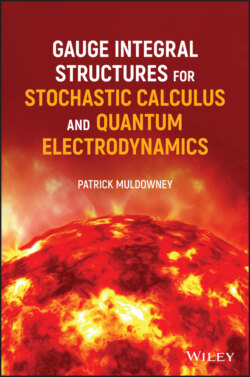Читать книгу Gauge Integral Structures for Stochastic Calculus and Quantum Electrodynamics - Patrick Muldowney - Страница 19
2.1 What is Random Variation?
ОглавлениеThe previous chapter makes reference to random variables as functions which are measurable with respect to some probability domain. This conception of random variation is quite technical, and the aim of this chapter is to illuminate it by focussing on some fundamental features.
In broad practical terms, random variation is present when unpredictable outcomes can, in advance of actual occurrence, be estimated to within some margin of error. For instance, if a coin is tossed we can usually predict that heads is an outcome which is no more or no less likely than tails. So if an experiment consists of ten throws of the coin, it is no surprise if the coin falls heads‐up on, let us say, between four and six occasions. This is an estimated outcome of the experiment, with estimated margin of error.
In fact, with a little knowledge of binomial probability distributions, we can predict that there is approximately 40 per cent chance that heads will be thrown on four, five or six occasions out of the ten throws. So if a ten‐throw trial is repeated one hundred times, the outcome should be four, five, or six heads for approximately four hundred of the one thousand throws.
Such knowledge enables us to estimate good betting odds for placing a wager that a toss of the coin will produce this outcome. This is the “naive or realistic” view.
Can this fairly easily understandable scenario be expressed in the technical language of probability theory, as in Chapter 1 above? What is the probability space ? What is the ‐measurable function which represents the random variable corresponding to a single toss of a coin?
The following remarks are intended to provide a link between the “naive or realistic” view, and the “sophisticated or mathematical” interpretation of this underlying reality.
The possible outcomes of an experiment consisting of a single throw of the coin are H (for heads) and T (for tails). Suppose a sample space for this experiment consists of the pair of numbers, and . Let be the family of all subsets of :
and define a probability measure by
Then, trivially, is a ‐algebra of subsets of , and is, trivially, countably additive1 on , so is a probability measure space.
The set of outcomes of a single throw of a coin is the set , and the family of subsets of is
and is a measurable space. Define the following function to represent the coin tossing experiment:
Then, for , so is a ‐measurable function.
There are many different ways of defining the probability space. It is natural to use real‐number‐valued functions, so the outcomes can be denoted and instead of H and T, and the measurable function can then be the identity function. (It is usual that the values of a random variable are represented as real numbers2 ; with expected—mean or average—value, variance, and so on; which are also real numbers.)
But no matter what way this construction is done, the classical, rigorous mathematical representation by measurable function is evidently more complicated than the naive or natural view of the coin tossing experiment. In contrast, the purpose of this book is to provide a rigorous theory of stochastic integration/summation which (like [MTRV]) bypasses the “measurable function” view, and which is closer to the “naive realistic” view.
